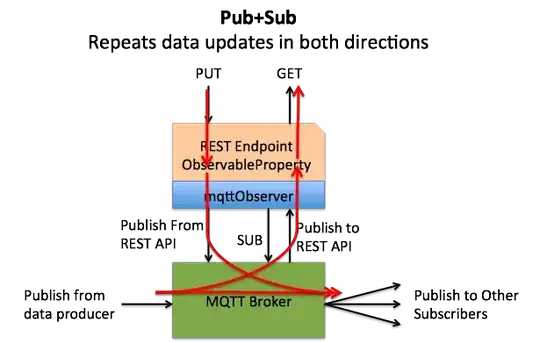Mapping URIs (from REST resources) to topics, depending on what your are modeling, could result in a perfect mapping.
Through a simple example, i will try to give you some hint about how to perform this mapping. I would take as an example, two APIS: a REST API (resources) and MQTT API (topics).
By the way, MQTT is a pub/sub protocol for the Internet of Things and M2M: there are some topics located in a MQTT broker where clients can publish (PUB topic1/topic2/...) or subscribe (SUB topic1/topic2/...) .
Hint 1: A resource representation is a message
The idea is to map your resource URI with a corresponding topic name. So the resource representation from a resource URI corresponds to a message in a topic.
Imagine you have a resource name /people/:id, you will have a corresponding topic name /people/:id.
So when a client make a PUT /people/1 { "loveBeer":true } , clients that have subscribe to this topic (through a SUB /people/1) will receive a notification. Notice that PATCH could be use also.
Same apply in the opposite, if a client post a message in the topic PUB /people/1 "loveBeer":true, the corresponding resource will be update.
You would end up with this kind of architecture (picture is taken from this blog) :

Hint 2: Resources creations are also messages
From the previous example, you could think...
Hey, what about client creating a new resource through POST /people ?
You will create a new resource and a message will be published in the corresponding topic (/people)
For example, if a client performs POST /people { "name":"schneider", loveBeer:true}. Clients that have performed SUB /people will receive the notification
So you could think again and say:
Hey, what about client publishing a message in a topic through PUB /people ?
Vice-versa, it will create a message in the topic /people and create a new sub-resource /people/:newid
Imagine a client make PUB /people {"name":"Ailurus", "loveBeer":true}, when message is receive, a new resource /people/42 is created and the clients have subscribed to /people are notified.
Bonus hint: Consider meta-data
That's not really a hint, since it's not really related to a mapping between resource URI/topic :)
From this blog, meta-data could be added in the payload of the messages published (but not in your resource representation).
Mainly because MQTT Client that subscribe to a topic don't know if a resource is updated or created, whereas a REST client know this information (when a resource is created, through the location header)
So consider to add a metadata such as "event": "created" or `"event": "modified"
You could even think about when a resource is created, in addition to put {"event": "created"} in the payload, to give the resource URI/topic name, such as {"event": "created", "location": "people/42"}
